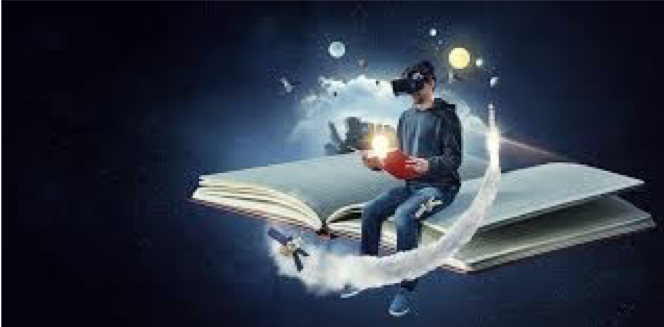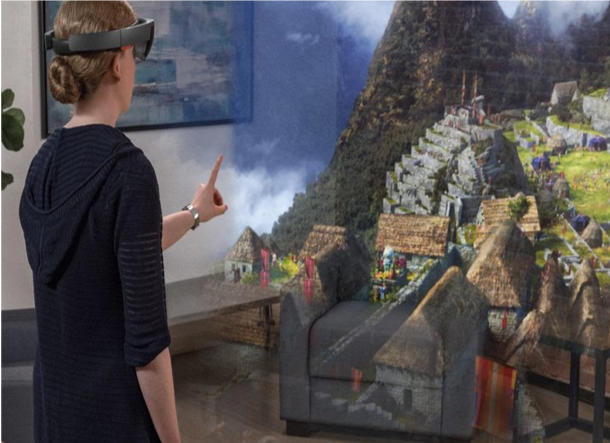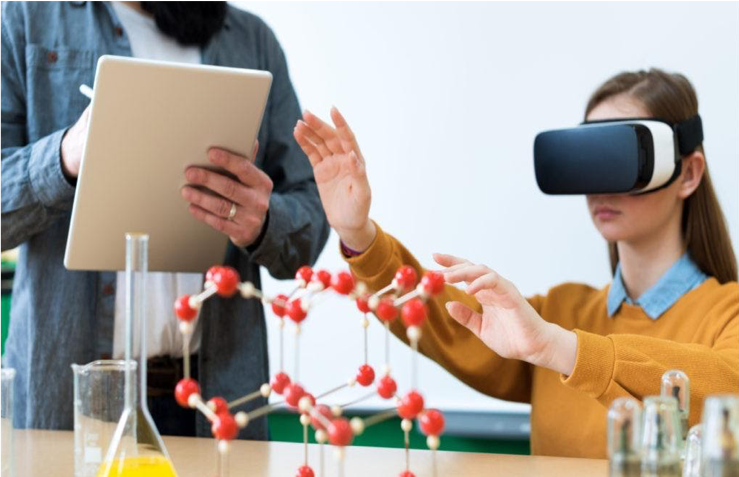A 9 year old boy comes home from school and asks his mother excitedly to guess which tour did he have today at his school. When his mother could not guess; he said that they went on the White House tour with the American president. This 9 years boy lives in Ahmedabad, India and for him this interactive experience was very fascinating, which he will probably never forget.
India has the world’s largest population of about 500 million in the age bracket of 5-24 years and this provides a great opportunity for the education sector. It has become the second largest market for e-learning after the US and this sector is expected to reach US$ 1.96 billion by 2021 with around 9.5 million users.[1]
While we understand the importance of the education sector in the growth of India, we also agree that the Indian Education System has to change with time. Education is no m ore about books and traditional student teacher classrooms. In this digital era, Virtual Reality seems to be the natural next step for the education sector where it can create experiential learning.
ore about books and traditional student teacher classrooms. In this digital era, Virtual Reality seems to be the natural next step for the education sector where it can create experiential learning.
This is not the first time we are thinking about this. Weeks of quarantine has made this thought even stronger.
What is Virtual Reality?
Virtual Reality (VR) is a computer interface which tries to mimic the real world beyond the flat monitor to give an immersive 3D visual experience. Often it is hard to reconstruct the scales and distances between objects in static 2D images. Thus, the third dimension helps bring depth to objects. It is a ground breaking new technology designed to help raise engagement and increase knowledge retention for students of all ages.
What can it change in the education sector?
India has established multiple institutes of excellence but rote learning method still continues where students study books primarily to score marks and crack exams to enter these institutions and there is less exposure of experiential learning. Fact retention and too much information makes it difficult to comprehend and visualise. The need to shift to experiential learning methods has always been a talking point. Let’s see how we are best suited to make it a reality now. Learning should be fun. Don’t you think? VR has the ability to introduce practical knowledge without even leaving the room. It removes the transport and logistics barrier, for instance, they can visit the Amazon rainforest or Eiffel tower or even the solar system from their classroom.[3]
Learning should be fun. Don’t you think? VR has the ability to introduce practical knowledge without even leaving the room. It removes the transport and logistics barrier, for instance, they can visit the Amazon rainforest or Eiffel tower or even the solar system from their classroom.[3]
VR education can transform the way educational content is delivered and allow users not only to see it, but also interact with it providing a better understanding through immersion.
Educators’ role will change from content delivery to content facilitation. Teachers will be focused on creating conditions for exploring, rather than providing ready-made knowledge.
Exciting? Right! But, Is INDIA Ready For This ?
VR content may need many times more storage space than an HD video, since many VR applications support real-time environmental changes and viewpoints served up to users almost instantly.[4] VR requires high bandwidth and speed of data. As the data generated will be huge we will need an efficient storage system to accommodate an influx of data. To achieve a fully-fledged system with this technology, India has to overcome a lot of challenges in infrastructure. There needs to be a proper bandwidth for seamless connection and high speed, huge and secured storage space as well as quality content.
Impact on Learning
VR proves to be a great tool, to eliminate all barriers and limitations to accessibility of various resources. It gives the flexibility of distance learning, bridging the gap between educators and learners. It will help students broaden their exposure to careers by exploring a day in someone’s career.

It has the ability to scale learning experience. A small VR device can act as a whole science lab. From chemical bond formations to chemical reaction, everything happens right in front of the learners through virtual reality.
That’s right. Isn’t that interesting? And that’s not all.
VR can also aid learners with special needs to focus attention on specific task and problem areas improving their learning capacity. The lack of building or lab equipment or laboratories will not affect the quality of education training.
VR in education makes it easy to engage students the whole time, making experiences memorable. It is useful not only for content consumption, but it’s also great for content creation, help them boost their creativity. Being able to visualize complex functions or mechanisms makes them easier to comprehend. This will be beneficial for high tech training, for example, medical students, group learning, internships, distance learning.
“Wow….. So why aren’t we doing that yet????”
Educator’s training and challenges
Usually, older educators are reluctant to change to the newer forms of education as they are not comfortable with the technology and digitalised, fast paced younger generation. With the advent of VR, it will be difficult for the educators to shift from their age-old learning method to new ways of experiential learning where the role of educator will change.
Reluctance to adapt with new technology and the changing teaching methods, will make them unfit for the sector and might lose their jobs. We will be losing knowledgeable, talented educators. There should be a continuous training process from the institute for the teachers so that sudden shifts does not feel like a drastic change to them and the focus of the institute should be to get quality content and keep the teachers updated with the technology.
Where can it be used?
VR training and education can be used for virtual field trips to engage students in geography, history or literature and get a better sense of places that cannot be visited physically.  Google expedition was one such idea where google piloted this program to hundreds of schools all over the world to visit places. VR can prove very effective in high tech jobs like in labs, or using machineries or in the medical industry to virtually see and learn the experiments in the lab or get trained for complex and risky surgeries without any risk to actual patients.
Google expedition was one such idea where google piloted this program to hundreds of schools all over the world to visit places. VR can prove very effective in high tech jobs like in labs, or using machineries or in the medical industry to virtually see and learn the experiments in the lab or get trained for complex and risky surgeries without any risk to actual patients.
Indian doctors have been using VR for cancer treatments and medical awareness. Global Hospitals Hyderabad hosted 1st live VR surgical training, students witnessing laparoscopy surgery. There is 40% drop in pain levels due to VR treatment said the bone cancer specialist Pramod Chinder.[5]
Good job!!!
“Is it going to be tough? Certainly.”
Apart from the education sector, Virtual reality will also have huge impacts in other sector like healthcare, gaming, entertainment and sports. However, there are certain challenges in order to implement this and make it successful.
One reason could be the unavailability of hardware and infrastructure in India. Given the lack of hardware, we are unable to scale fast. Also, along with the hardware components, India lacks the ecosystem or environment to boost adoption in the country like the internet bandwidth and mobility, or display mediums. VR demands a lot of bandwidth, and a complete rollout of 5G bandwidth is necessary. The scarce talent, lack of content or content makers will be another key reason for the difficulty in VR implementation
According to the 2017-’18 National Sample Survey report on education, only 24% of Indian households have an internet facility.[6]
Oooh…that seems a challenge.
Absence of digital infrastructure is a big hurdle now. To get an immersive environment, it takes a good infrastructure and equipment, but will it be affordable?
Maybe or Maybe not…..We will see.
The technical know-how will be a challenge in most of the educational institutions in India. Most of the rural places do not have access to basic technology and making it accessible to them as well as teaching them about the technology will be a hurdle where both the educators and learners might be using the technology for the first time.
The reluctance to adapt to new technology and style of teaching as well as coming up with a standardised curriculum for such a diversity will be difficult.
Moving Forward
In order to implement the new technology and transform the education industry, steps and measures should be taken to overcome challenges. The government should redefine policies to increase penetration and accessibility of digital technology and improve digital infrastructure. The institutions should start preparing for the change and keep the infrastructure ready as well as give proper training to the educators as well as the learners to make this transition smooth. The educators should start changing the teaching methods according to the technology and keep themselves updated and push students into more experiential learning methods. The era of VR education is just being started and there lies an exciting future ahead for the education industry.
Written by – Shanaz Begum (IIM Rohtak)
Intern at Indiabiz
Hi,
I have client with interests in the edu aector who may like to explore this partnership.
Please advise.
Thx,
Mayur Ambiye
+91-97400-70189
Hi Mayur, you will get contacted by our team, where are you based?
Hi Dude
Thanks for sharing the interesting article about the educational tour blogs , after reading feels like wanna visit such kind of places . Kindly please share more and more blogs